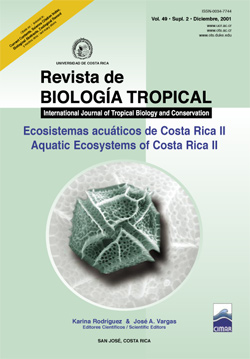Abstract
The seasonal variation of planktonic primary productivity was measured during one year in the main channel in the interior part of the mangrove forest of the Estero de Morales (Estero de Punta Morales), a mangrove system located in the Golfo de Nicoya at the Pacific coast of Costa Rica. Samples were incubated at the surface, 0.5 m and 1.0 m depth and the “light and dark bottle technique” was employed. The annual gross primary productivity (PPg) was 457 and the net primary productivity (PPn) was 278 g C m–2 a-1. Daily PPg ranged from 0.29 to 3.88 and PPn from 0.12 to 2.76 g C m-2 d-1. The highest rates observed in May and September were due to red tide blooms. The seasonal variation of primary productivity inside the mangrove forest depends closely on the PP in the adjacent area of the upper Golfo de Nicoya. Obviously the PP was light-limited since the compensation depth in the ebb current was found at only 1m depth. In the flood current it was somewhat deeper. The planktonic primary productivity inside the mangrove forest was completely restricted to the open channels. A simultaneous measurement demonstrated that PPn of the phytoplankton could not take place under the canopy of the mangroves. Additional studies on the time course of the oxygen concentration in the mouth of the main channel over 24 hrs demonstrated a relation between the O2 and the tidal curves. The ebb current had always lower O2 concentrations than the flood current, regardless of the time of the day. The difference to the foregoing high tide, however, was much smaller when the low tide occurred during the day. This indicates that under the canopy the net primary production and hence O2 liberation of the attached macro- and microalgae, together with the high PPn of the phytoplankton in the channels, helped the oxygen concentration not to decrease as far as during the night. Nevertheless it shows that the consumtion of organic material in the submersed part of the mangrove forest exceeds always its production.References
Bryan, J.-R., J. P. Riley & P. J. LeB. Williams. 1976. A Winkler procedure for making precise measurements of oxygen concentration for productivity and related studies. J. Exp. Mar. Biol. Ecol. 21: 191-197.
Cebrián, J. & C. M. Duarte. 1994. The dependence of herbivory on growth rate in natural plant communities. Funct. Ecol. 8: 518-525.
Chale, F. M. M. 1996. Litter production in an Avicennia germinans (L.) stearn forest in Guayana, South America. Hydrobiologia 330: 47-53.
Córdoba-Muñoz, R. 1998. Primary productivity in the water column of Estero de Morales, a mangrove system in the Gulf of Nicoya, Costa Rica. Rev. Biol. Trop. 46 Suppl. 6: 257-262.
Duarte, C. M. & J. Cebrián. 1996. The fate of marine autotrophic production. Limnol. Oceanogr. 41: 1758-1766.
Fogg, G. E. 1963. The ecological significance of extracellular products of phytoplankton photosynthesis. Bot. Mar. 26: 3-14.
Gaarder, T. & H. H. Gran. 1927. Investigations of the production of plankton in the Oslo Fjord. Rapp. et Proc. Verb., Cons. Internat. Explor. Mer 42: 1-48.
Gocke, K, J. Cortés & C. Villalobos. 1990. Effects of red tides on oxygen concentration and distribution in the Golfo de Nicoya, Costa Rica. Rev. Biol. Trop. 38: 401-407.
Gocke, K., M. Vitola & G. Rojas. 1981. Oxygen consumption pattern in a mangrove swamp in Costa Rica. Rev. Biol. Trop.29: 143-154.
Green, E. & D. E. Carrit. 1966. An improved iodine determination flask for whole bottle titration. Analyst. 91: 207-208.
Harrison, P. J., N. Khan, K. Yin, M. Saleem, N. Bano, M. Nisa, S. I. Ahmed, N. Rizvi & F. Azam.1997. Nutrient and phytoplankton dynamiccs in two mangrove tidal creeks of the Indus River delta, Pakistan. Mar. Ecol. Prog. Ser. 157: 13-19.
Lalli, C. M. & T. R. Parsons. 1997. Biological oceanography : an introduction. Second edition. The Open University Oceanography Series. Butterworth- Heinemann, Oxford. 314 p.
Lee, S. Y. 1990. Primary productivity and particulate organic matter flow in an estuarine mangrove-wetland in Hong-Kong. Mar. Biol. 106: 453-463.
Lee, S. Y. 1995. Mangrove outwelling: A review. Hydrobiologia 295: 203-212.
Mackey, A. P. & G. Smail.1995. Spatial and temporal variation in litter fall of Avicennia marina (Forssk.) Vierh. in the Brisbane River, Queensland, Australia. Aquat. Bot. 52: 133-142.
Nixon, S. W. 1980. Between coastal marshes and coastal waters – A review of twenty years of speculation and research on the role of salt marshes in estuarine productivity and water chemistry. p. 437-525. In P. Hamilton & K. MacDonald (eds.). Estuarine and Wetland Processes. Plenum. New York.
Odum, E. P. & A. A. de la Cruz.1967. Particulate organic detritus in a Georgia salt marsh estuarine ecosystem. p. 383-388. In G. H. Lauff (ed.). Estuaries. Amer. Ass. Adv. Sci. Publ. 83. Washington DC.
Peterson, C. L. 1958. The physical oceanography of the Gulf of Nicoya, Costa Rica, a tropical estuary. Bull. Int. Amer. Trop. Tuna Comm. 4: 139-214.
Pool, D. J., S. C. Snedaker & A. E. Lugo. 1977. Structure of mangrove forests in Florida, Puerto Rico, Mexico and Costa Rica. Biotropica 9: 195-212.
Ryther, J. H. 1956. The measurement of primary production. Limnol. Oceanogr. 1: 72-84.
Tam, N. F. Y., Y. S. Wong, C. Y. Lan & L. N. Wang. 1998. Litter production and decomposition in a subtropical mangrove swamp receiving waste water. J. Exp. Mar. Biol. Ecol. 226: 1-18.
Twilley R. R., A. E. Lugo & C. Patterson-Zucca. 1986. Litter production and turnover in basin mangrove forests in southwest Florida. Ecology 67: 670-683.
Wolff, M., V. Koch, J. B. Chavarría & J. A. Vargas. 1998. A trophic flow model of the Golfo de Nicoya, Costa Rica. Rev. Biol. Trop. 46 (Supl. 6): 63-79.
##plugins.facebook.comentarios##

This work is licensed under a Creative Commons Attribution 4.0 International License.
Copyright (c) 2001 Revista de Biología Tropical


